
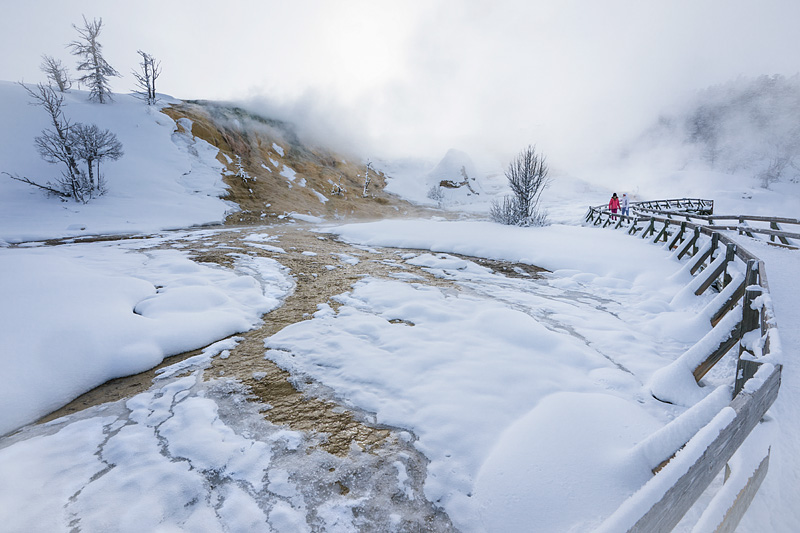 Winter is a magical time to visit Yellowstone’s Mammoth Springs…
Winter is a magical time to visit Yellowstone’s Mammoth Springs…
when wisps of hot steam hitting icy air create thick rime frost that coats bare tree branches and wooden boardwalks edging the hot springs… transforming this geothermal wonderland into a fantasy fairyland.

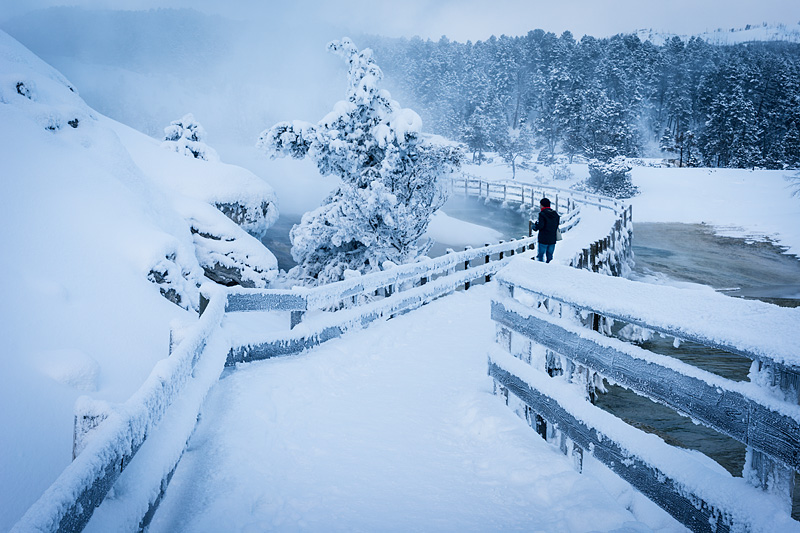 Elsewhere, bison in their snow-matted fur lumber quietly through the wilderness swaying their 300 lb heads side-to-side as they clear snow from the ground to find something to eat. Or stand frozen beside steaming creeks. Elk move more elegantly up the hills, leaving narrow paths in the deep snow. Moose, bighorn sheep, coyotes, and wolves are there too…trying their best to remain hidden in Lamar River Valley.
Elsewhere, bison in their snow-matted fur lumber quietly through the wilderness swaying their 300 lb heads side-to-side as they clear snow from the ground to find something to eat. Or stand frozen beside steaming creeks. Elk move more elegantly up the hills, leaving narrow paths in the deep snow. Moose, bighorn sheep, coyotes, and wolves are there too…trying their best to remain hidden in Lamar River Valley.

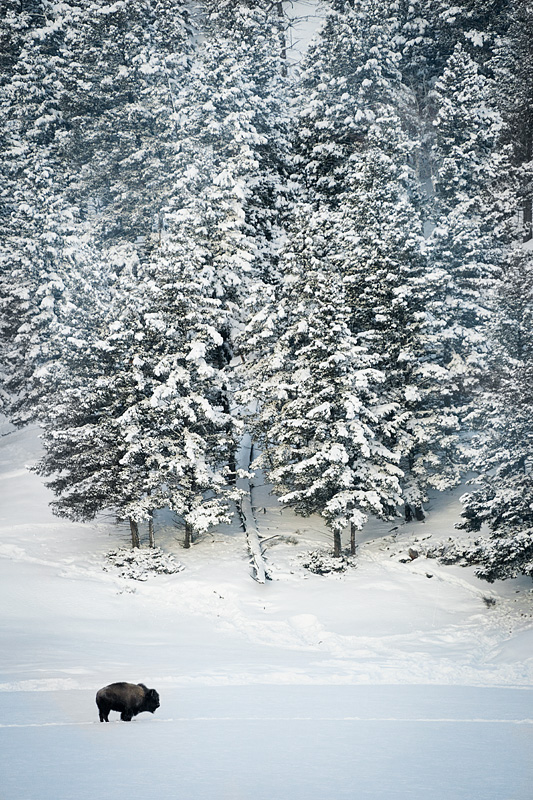
Wildlife is easier to spot against a blanket of white. And the road heading to Lamar Valley isn’t congested like it is other times of the year. In fact, there are more tourists visiting Yellowstone in a single summer day than there are in the entire winter season. Winter has zero crowded masses. Perfect for photographers, couples seeking a romantic getaway, cross country skiers or solo adventurers. Or families on winter school breaks that want to combine a quick trip to Yellowstone with skiing in Bozeman’s Bridger Bowl or Big Sky.
Getting Here:
Mammoth Hot Springs Inn is one of two lodges open during winter months. (Old Faithful Snow lodge is the most difficult to reach and requires snow coach transportation from West Yellowstone, Montana, or from Mammoth Hot Springs ($123 each way per person). For more info on this lodge see an earlier post: Old Faithful)
Mammoth Hot Springs is the only part of Yellowstone National Park that can be accessed by car all year long. Located in Yellowstone’s northern region, its entrance lies just beyond Gardiner, Montana (a 2 hour drive SE from Bozeman). The 3 main areas of interest here are the terraced Hot Springs, Lamar River Valley & Norris Geyser Basin.
Mammoth Hot Springs:
Star Trek fans may recognize this area as the planet Vulcan. White chalky terraces cascade down a hillside just a ten minute walk from the inn. A 1.5 mile wooden boardwalk winds around the calcified terraces, colorful hot springs, travertine pools and hissing steam vents in the maze-like Lower Terraces.

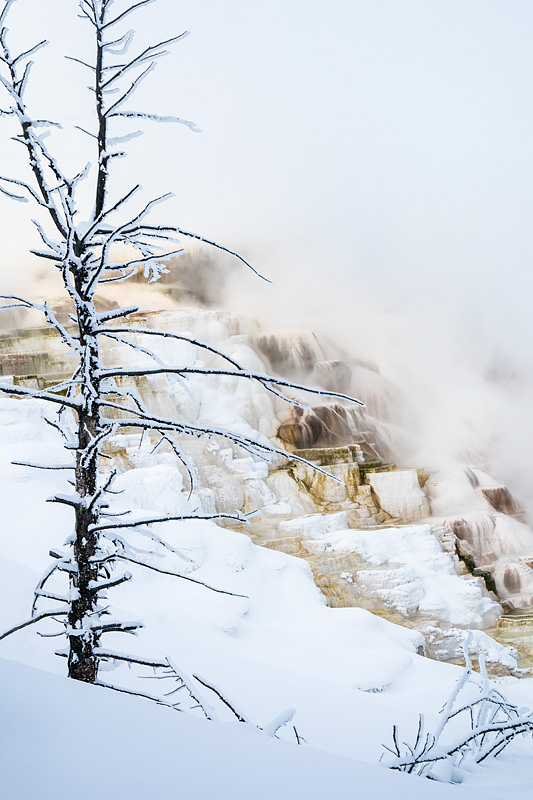
Take your time around Minerva Terrace to carefully observe the pattern, texture and tinted color details of the thermophiles (heat-loving bacteria) along the dissolved limestone surfaces.

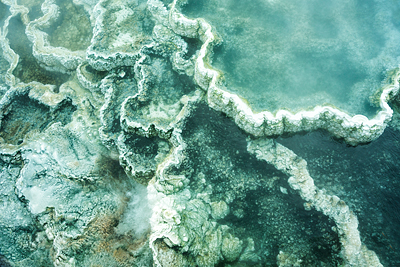
There is also a deep snow trail in a pristine forest leading to Cleopatra Terrace. When you follow this path expect to sink up to your knees with each step and enjoy peaceful solitude with nary a soul in sight!

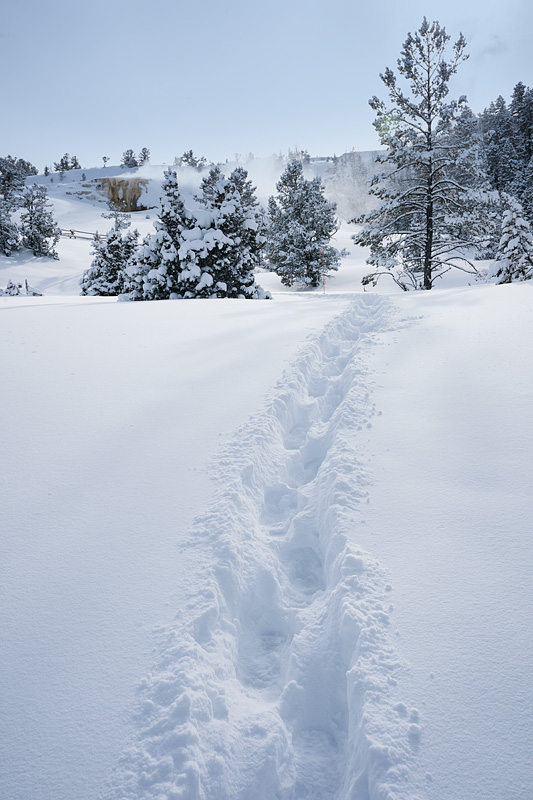
Every time I went out to explore, I spent 2-3 hours on the Lower Terraces. This boardwalk is only open to hikers in the winter, whereas the smaller trail around the Upper Terraces (which is a paved road in summer) is only open to cross country skiers or snowshoers. The shop in the inn rents equipment for both sports.
On Wednesday and Saturdays, a park ranger leads guided snowshoe treks around the Upper Terrace. I showed up for the free tour and joined a couple families and another solo traveler for the two hour snowshoe excursion. We followed our guide around the loop on a wide path, stopping often to catch our breath and learn about the geology of the area.

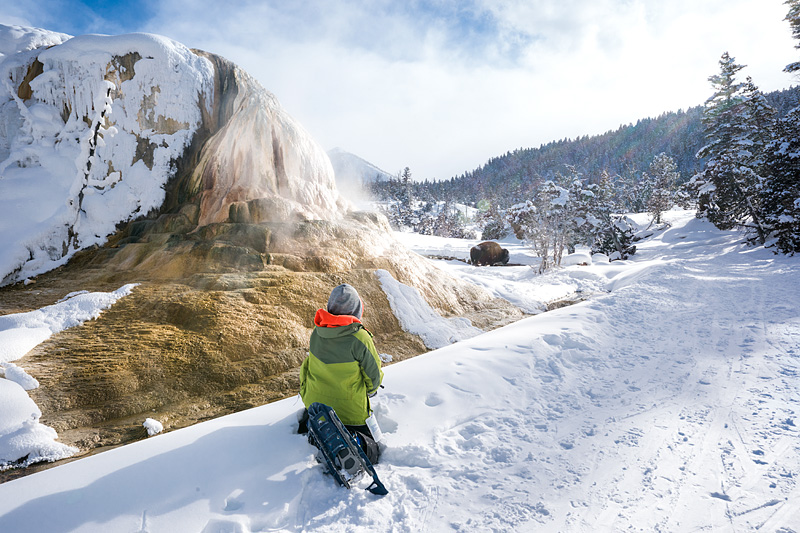 As we rounded Orange Spring, about half way around the loop, we came across a bison slowly grazing in the snow. We waited for 10-15 minutes for him to move on so we could access the trail, but he was content to hang out there. So we were forced to backtrack the way we’d come and missed seeing three of the features on the trail. Visitors are warned to keep a safe distance from all wildlife, including bison (minimum of 25 ft, or 2 bus lengths). Bison may look lazy and slow, but they can actually run 37 mph and even jump 6 ft fences from a standing still position!
As we rounded Orange Spring, about half way around the loop, we came across a bison slowly grazing in the snow. We waited for 10-15 minutes for him to move on so we could access the trail, but he was content to hang out there. So we were forced to backtrack the way we’d come and missed seeing three of the features on the trail. Visitors are warned to keep a safe distance from all wildlife, including bison (minimum of 25 ft, or 2 bus lengths). Bison may look lazy and slow, but they can actually run 37 mph and even jump 6 ft fences from a standing still position!

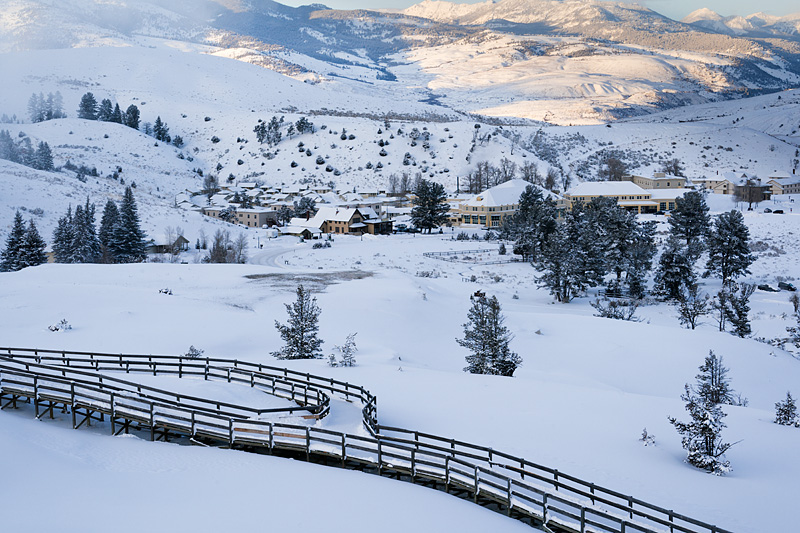
Tips: wear yaktrax on your boots for added traction. The boardwalk isn’t shoveled and can get icy. Be prepared for lots of stairs! Again, the stairs aren’t shoveled, so most people grab the railing and simply slide down the stairs after a heavy snowfall. Wear snowpants. Wrap a scarf to reduce windburn on your face. Bring insulated boots designed for subdegree temps, like my Baffin boots which are good for minus 40! Bring a flashlight if you head out in the late afternoon. Time can evaporate quickly and you may find yourself lost in the beauty of Canary Springs when the sun disappears. Also, look out for bison who may be crossing the road at dusk and passing really close to the boardwalk entrance en route to warmth from a nearby creek. Can be alarming when a bison bull simply decides to stand at the boardwalk entrance and stare you down on your way back home! Kinda have to wait for him to move…and that can certainly be awhile! If you’re out on your own, a whistle is also nice to have if you get blocked by bison in the dark and need to alert any shadowy figures heading to back to their car who can help scare off the animal or perhaps take you back to the inn.


Lamar River Valley:
Most people come to this northeastern section of Yellowstone to search for wildlife. The big guys….like wolves, bighorn sheep and moose. During cold months, the snow drives the animals from high mountain ridges down to open pastures closer to the road to hunt for food. Lucky for tourists!
Also lucky is that students in Cooke City have to go to school in Gardiner. That means that this same paved road that’s kept plowed for school buses to safely transport kids back and forth also happens to be the road that travelers use to pass through the grand scenic vistas of Lamar River Valley. Tourists travel this road all year round, stopping at pullouts to search for and admire the wildlife.
The road heads east from Mammoth Hot Springs along Highway 212 through Lamar Valley all the way to Cooke City, where this winter road deadends. Be aware that snow plows don’t operate during blizzards. Such was the case for 2 days prior to my visit when the road was closed.
The road was still pretty slick when it reopened. I traveled through Lamar Valley on a bus tour from Mammoth Hot Springs Inn. I signed up for the Wake up to Wildlife tour which left at 6:45am. There’s also another tour, Lamar Valley Wildlife, which lasts a wee bit longer. There are also programs devoted just for wolves through an adjacent research station. Yellowstone supposedly has 100 wolves living in 10 packs, and rates as one of best places in the world to see them.
To be honest, I just wanted to see a red fox. Even better if he was pouncing on fresh prey in the snow!
The bus tour was an enjoyable morning in the park. Our guide entertained us with stories about some of the early pioneers, a poacher, and a poor man who was lost in Yellowstone for 37 days during an 1870 expedition. Later back at the inn, I found his book “37 Days of Peril” and read it on loan from the Map Room library.

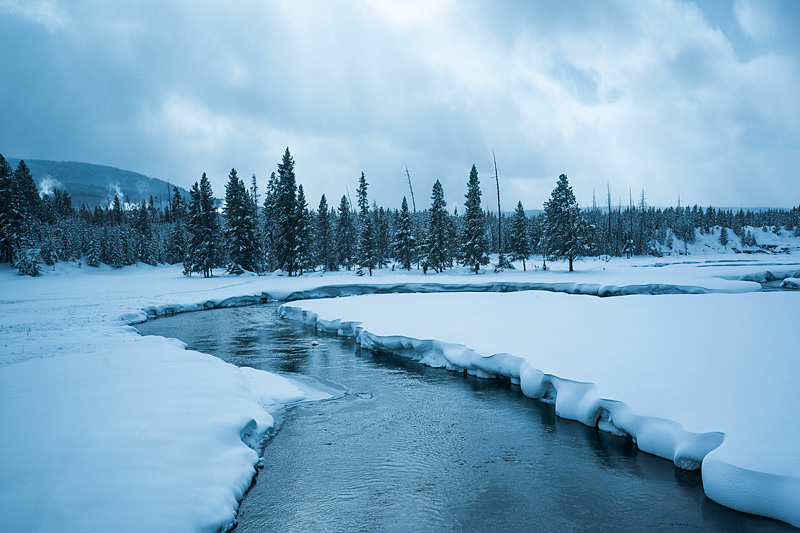 During the bus tour that cold morning, we saw plenty of bison…on the road, in deep snow, among willows, and in the distance. We also saw 4 coyotes up on a hilltop sleeping, all huddled down in the snow to keep warm. It was -38 F that morning. If my hand warmers failed to keep my fingers warm while riding a bus imagine sleeping outdoors!
During the bus tour that cold morning, we saw plenty of bison…on the road, in deep snow, among willows, and in the distance. We also saw 4 coyotes up on a hilltop sleeping, all huddled down in the snow to keep warm. It was -38 F that morning. If my hand warmers failed to keep my fingers warm while riding a bus imagine sleeping outdoors!
Our guide provided glimpses of bighorn sheep through her scope, and even found some antlered elk. Two moose were wandering among willows along a creek. And an eagle perched in a tree. But sadly, no fox.

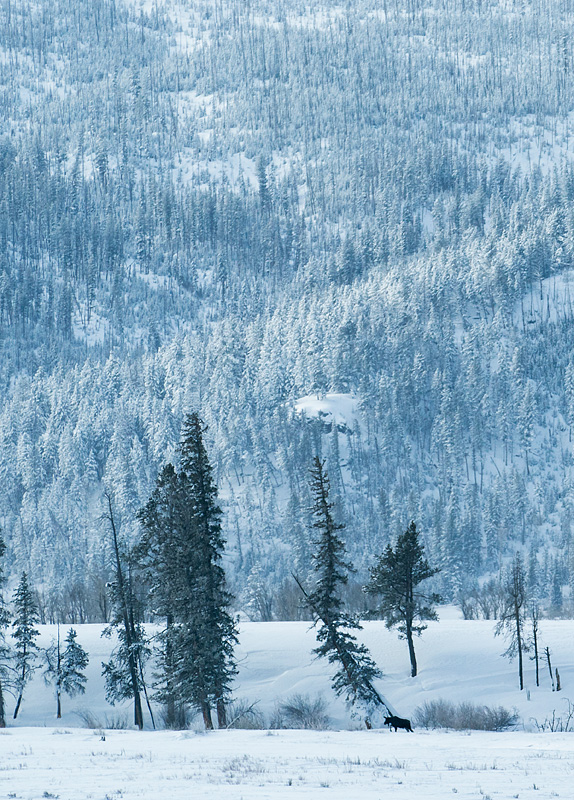 Although the bus tour is entertaining, informative and necessary for those of us traveling without a car, it does pose a few drawbacks. The bus can only stop in a pull out space. But cars can pull over on the side of the road whenever drivers spot something of interest. As passengers on the bus, we were often forced to shoot through the windows of a moving vehicle. Our tour ended around 11am, but people with their own vehicles can linger at whim and drive all the way to Cooke City and back.
Although the bus tour is entertaining, informative and necessary for those of us traveling without a car, it does pose a few drawbacks. The bus can only stop in a pull out space. But cars can pull over on the side of the road whenever drivers spot something of interest. As passengers on the bus, we were often forced to shoot through the windows of a moving vehicle. Our tour ended around 11am, but people with their own vehicles can linger at whim and drive all the way to Cooke City and back.

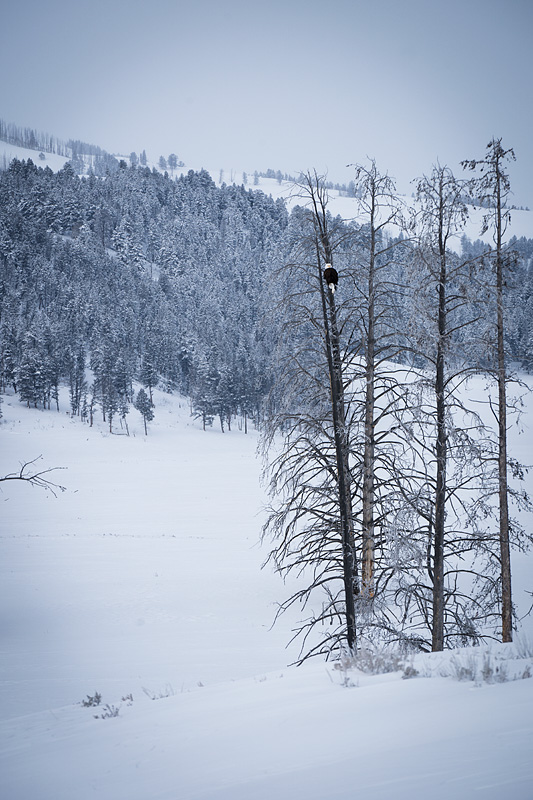
Tips: make an effort to spend a day traveling through this valley! Drive yourself if you have a car and road conditions allow. Or decide in advance to book a bus tour. Choose a window seat near the front of the bus, for photography and quick access to the door when the bus stops. Try using a polarizer on your lens to combat the reflections in the windows. Prefocus your camera and choose a fast shutter speed so you can simply aim and fire as you drive past scenes or animals in the bus. Bring extra hand warmers and protein snacks. (A sugary blueberry muffin and apple juice are provided on the bus tour.) Bring a long lens to shoot wildlife. Chances are the animals will be very distant. Serious wildlife photographers were standing on the side of the road with 600mm lenses pointed at a mountain ridge waiting 2 hours for those distant coyotes to wake up…
Norris Geyser Basin

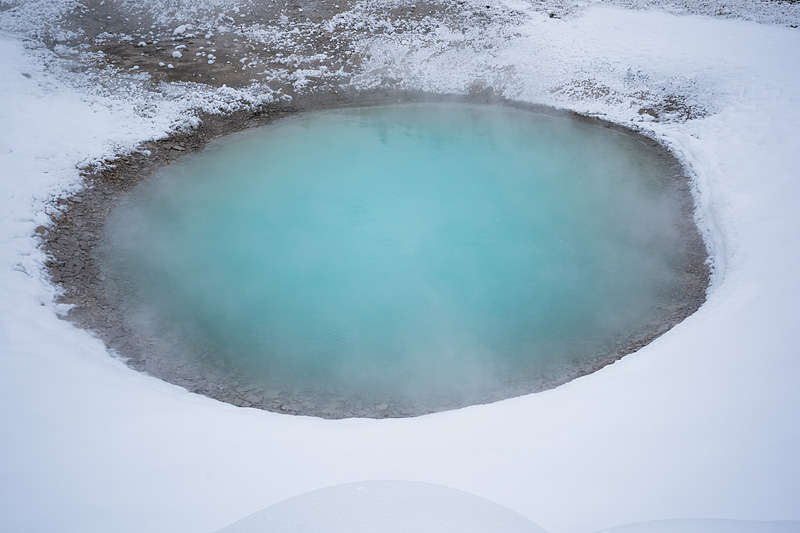
This geothermal region may appear quite peaceful in the winter. But what lies beneath the surface is quite volatile. Magma is closer to the surface than any other place in Yellowstone, and the water 1,000 ft below reaches an astounding 459 F degrees! Seismic volcanic activity and location to 3 major faults creates ever-changing features along the thin fragile crust.
There are two distinct areas to visit. The smaller area, Porcelain Basin, has a boardwalk loop around a wide open space with water features while the much larger Back Basin has a forested trail with isolated springs and geysers. The world’s largest geyser is here. Steamboat Geyser can spew 300 ft. But when it blows is anybody’s guess. Lapses between eruptions can be anywhere from 4 days to 50 years.

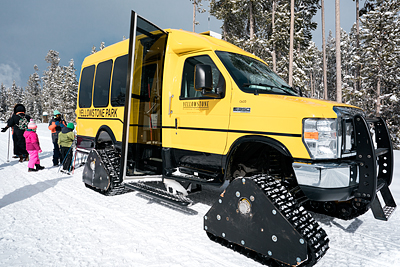
The only way to visit during winter is to join a snow coach tour from Mammoth Hot Springs Inn. (Or snowmobile here on your own.) There are only 13 spots, and the tour only operates 3 times a week. It’s a fun afternoon excursion. I loved this tour!
The snow coach was comfortable travel and passed beautiful scenery along the 45 minute drive. When we arrived, our guide offered hiking poles to help navigate the snowy terrain. We proceeded to explore on foot and headed to Porcelain Basin, one of two separate hydrothermal areas.

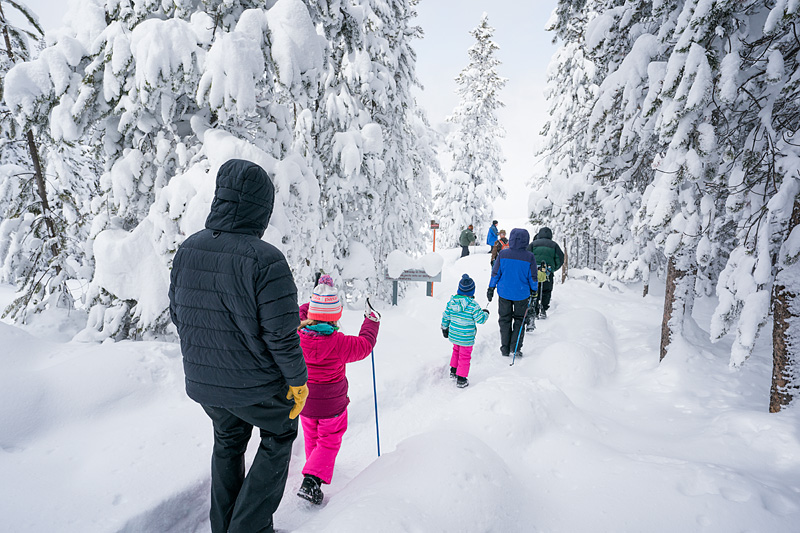
The boardwalk was buried under a couple feet of snow, but previous hikers had helped pack down a rough uneven path.

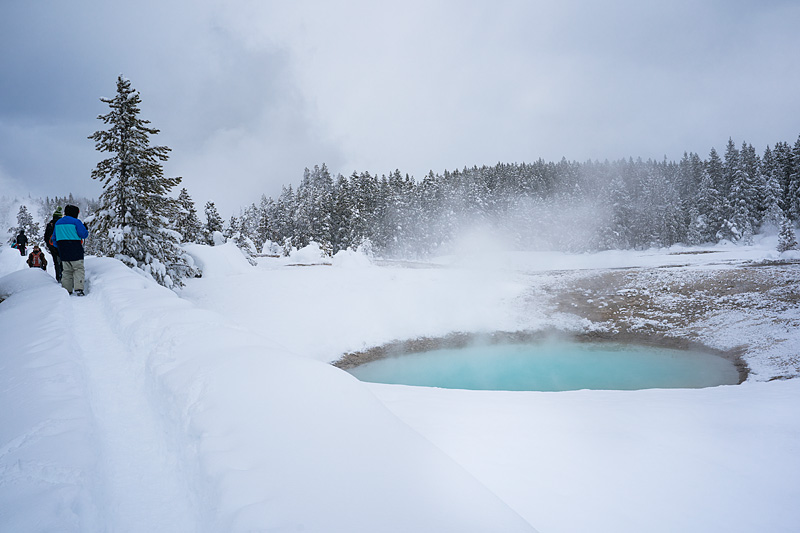
The acidic hot springs at Porcelain Basin were marked by sulfur odors, hissing steam, colorful thermophiles and algae. We only made it to Whirligig Geyser before we had to retrace our route due to deep unpassable snow that blocked the rest of the loop trail.

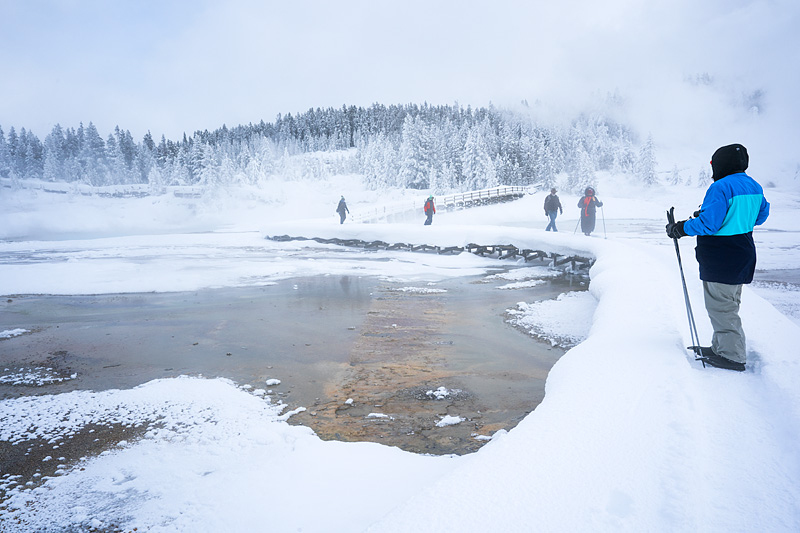
Back at the trailhead, our guide offered to take anyone willing to explore the Back Basin. Most of us were game, while a few others went back to the snow coach.

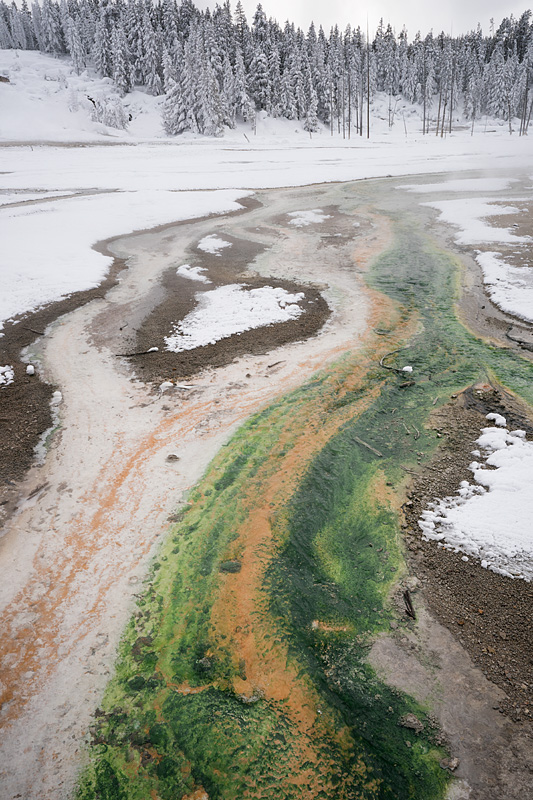
Since it was such a cold windy day, the hot steam mixing with the icy air created thick fog that moved in waves, causing poor visibility of the geothermal features. We stood in front of Steamboat Geyser watching sporadic jets of water erupt 10-40 ft. Those with children turned back here, but a few of us carried on with the guide and hiked along a snowy boardwalk until we came to another deadend at Mystic Spring.

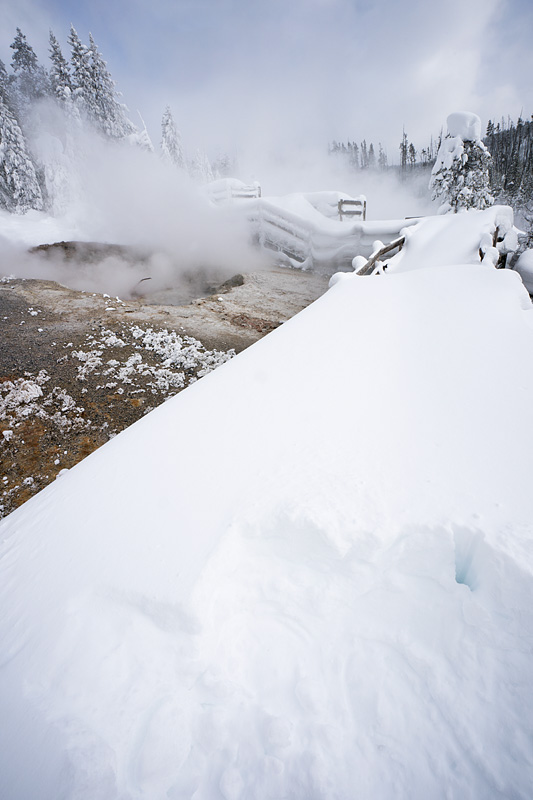 On the way back our guide pointed out the unusual Needle Ice which only occurs in extremely cold conditions. The straw-like ice formations growing on the thin limestone surface were 2 inches tall.
On the way back our guide pointed out the unusual Needle Ice which only occurs in extremely cold conditions. The straw-like ice formations growing on the thin limestone surface were 2 inches tall.

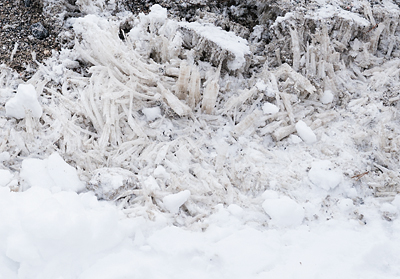
She also pointed out Rime frost on the trees created from frozen steam as we passed through the forest. All tours are better when guides like her possess a genuine sense of wonder as they explore a place together. I appreciated her enthusiasm and eagerness to keep hiking despite others waiting on the bus.

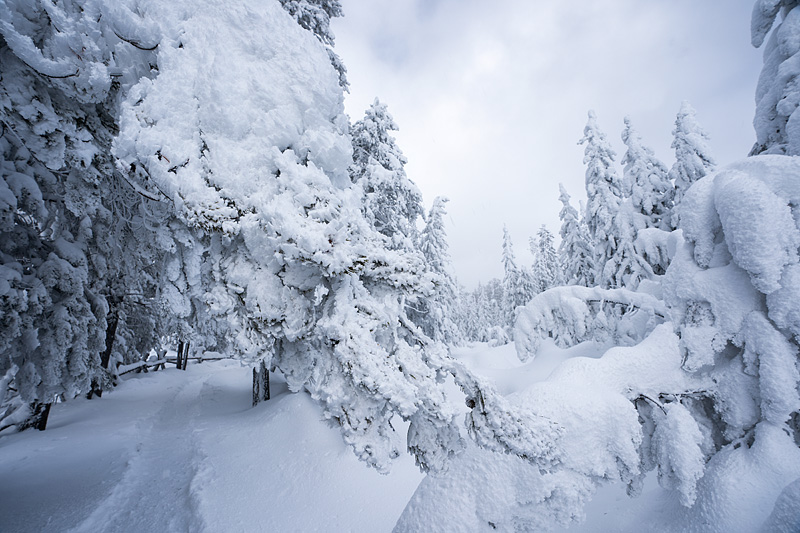
Tips: as soon as you book your Mammoth Hot Springs lodging, book this tour! It sells out quickly. When I booked my lodging, there was just one spot left. So glad I nabbed it! Bring extra handwarmers. Sometimes they fail (like mine did). Use yaktrax that strap onto your boots. Mine had a rubber ring to pull over my boots but they kept slipping off. There were no up and downs or rocks to scramble over. I’m glad I bypassed the offer of using hiking poles as I saw others simply carrying their poles on the mostly flat terrain. Use a camera bag to keep your camera protected from snow if you fall and steam when the thick fog blows your way. Save 15% of the tour cost when you book the Wake up to Wildlife tour for the same day.
Mammoth Hot Springs Inn
Location, location, location…If you like being close to the hot springs and near the center of activity you can’t go wrong staying in this historic hotel. I loved being able to wander down the road to explore the springs on my own, and spent 3-6 hours walking around there daily.

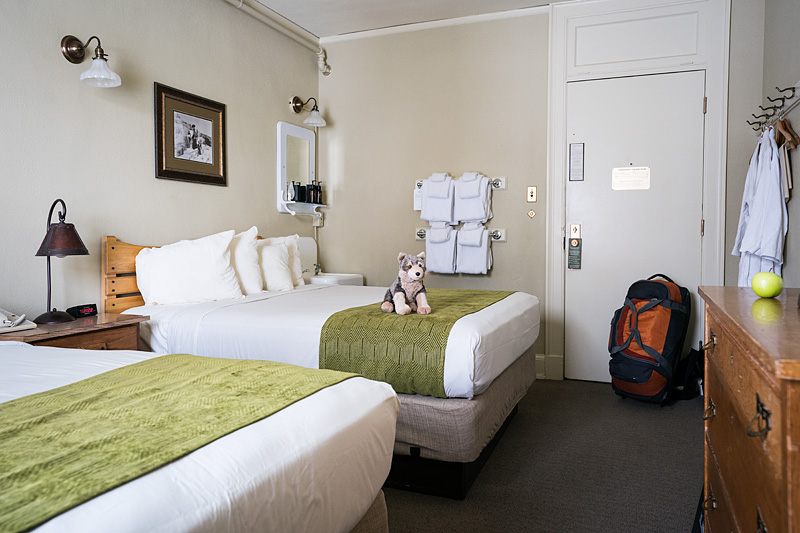 Rooms have shared or private bathrooms. The hotel’s spacious Map Room has cozy sitting niches for couples or open spaces for families to play board games, and a grand piano that a pianist plays most evenings. Tucked into a corner is a bar that serves morning coffee or evening liquor.
Rooms have shared or private bathrooms. The hotel’s spacious Map Room has cozy sitting niches for couples or open spaces for families to play board games, and a grand piano that a pianist plays most evenings. Tucked into a corner is a bar that serves morning coffee or evening liquor.

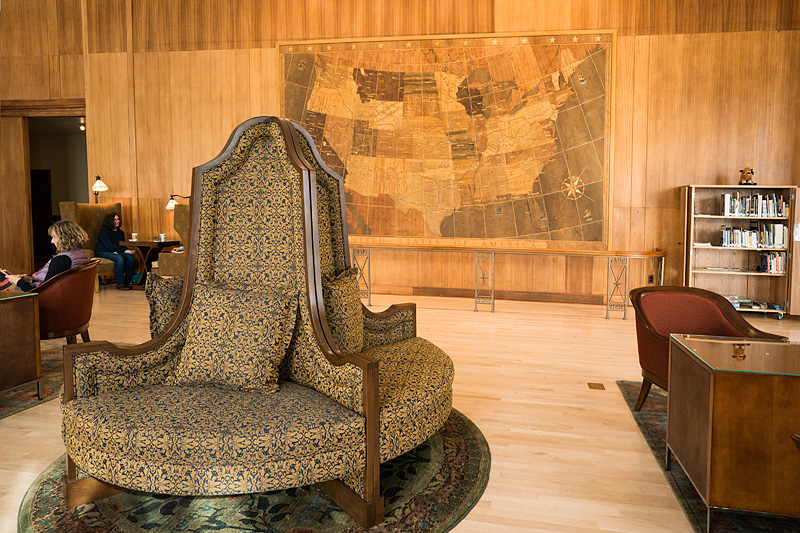 A small gift shop sells souvenirs but also rents snowshoe and ski equipment, and handles ski shuttle bookings to area trailheads. The restaurant is located in another building across the street (not so handy for those with mobility issues when road is icy) and only accepts dinner reservations in advance.
A small gift shop sells souvenirs but also rents snowshoe and ski equipment, and handles ski shuttle bookings to area trailheads. The restaurant is located in another building across the street (not so handy for those with mobility issues when road is icy) and only accepts dinner reservations in advance.

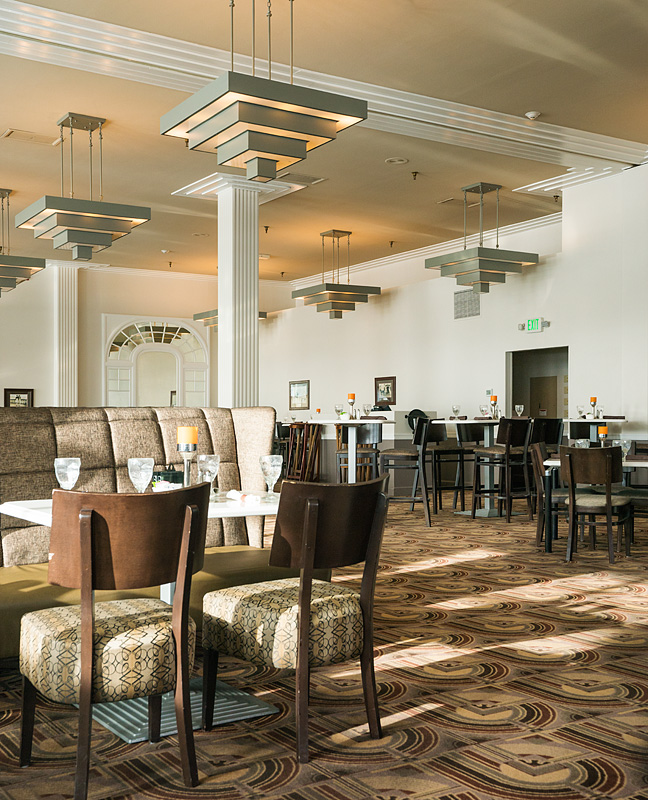
Beyond the restaurant is a General Store that sells a little bit of everything from huckleberry wine and chocolates to cheese, toiletries, clothing and local art work. A deli counter open for lunch serves chili and sandwiches. And sometimes has front window seats to passing elk!

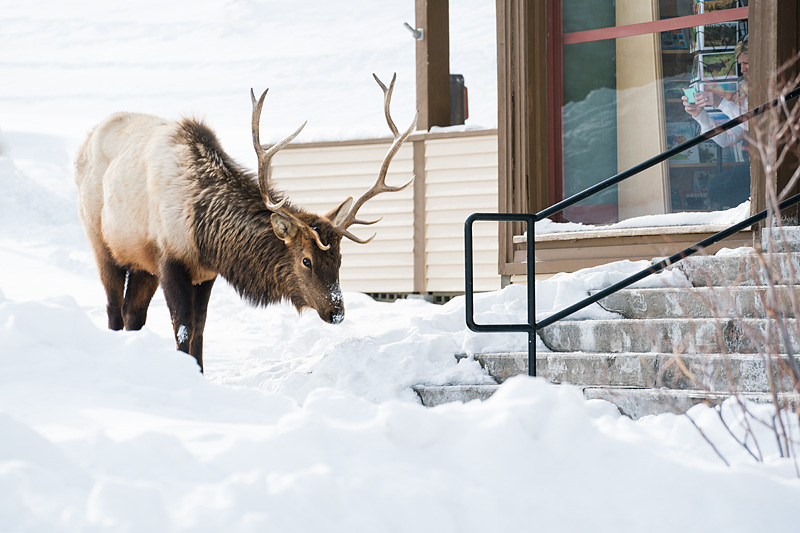 Across the street is a Visitor Center with animal and geology displays and historical information about the formative early years of our nation’s first park in the basement. If rangers are on hand can’t answer your questions, you may find what you’re looking for in their comprehensive book store.
Across the street is a Visitor Center with animal and geology displays and historical information about the formative early years of our nation’s first park in the basement. If rangers are on hand can’t answer your questions, you may find what you’re looking for in their comprehensive book store.
Money saving tips:
Lodging:
Consider booking a room at Mammoth Hot Springs Inn with a shared bathroom. Rates drop from $164 to $95 a night. Also ask for the Softer Green Stay. If you don’t mind skipping maid service, you save $5 a night. My room had 2 queen beds, a dresser, sink and bathrobes for the shared bathroom across the hall. Even though there is only one female shower per floor, I never had to wait. The room was great! Alternatively, if you have your own car (or the park inn is full) you could always book a room in Gardiner, MT which is 5 miles away.
Food:
Save money by eating a late breakfast (great omelettes) and an early dinner, skipping lunch. Or head to the General Store for nuts, cheese or deli lunch. Entrees at dinner range from $21-38, but menu choices include burgers and small plates. A sweet potato stuffed with wildlife chili was very satisfying ($7.25). But pairing a cup of soup ($4.30) with their warm goat cheese salad with pinenuts, bacon and mixed greens ($10.50) was my favorite dinner selection.
Activities:
Explore the boardwalks around the springs free of charge! Walk around the historic army buildings. Join a free ranger-led snowshoe tour. (Rent the snowshoes in the gift shop for $13.) Ice skate for free behind the hotel (skates provided). Attend the free lectures or slide shows about Yellowstone in the evening at the hotel. Get close to wildlife by wandering around the inn at dusk! A few elk seem keen on foraging for food behind the General Store hill and often keep walking right up to the inn. Likewise bison can be spotted a few minutes walk past the General Store along the dormant cone or Beaver Ponds creek trail. Just keep your distance!

 Communication:
Communication:
Beware that you will likely not have any cell service within Yellowstone National Park. Only Verizon apparently works! This was a bit of a surprise and prevented me from communicating with friends staying in Gardiner. The inn does have internet service for purchase (by the minute) but only works in the restaurant bar, and isn’t cheap. The absence of noise was apparent here, which I really liked. No tv, radio, or canned music. And instead of chatting on their phones in the Map room, people were conversing over drinks or playing games together. The Inn rooms were so quiet that I could hear wolves howling in the wee hours of the night. Yes, really. Wolves. Now that’s a perk!
[booking_product_helper shortname=”yellowstone”]
~~~~~~~~~~~~~~~~~~~~~~~~~~~~~~~~~~~~~~~~~~~~~~~~~~~~~~~~~~~~~~~~~~~~~~~~~~~~~~~~~~~~~~~~~~~~~~~~~~~~~~~~~~~~
Have a Pinterest travel board? Then pick one, and Pin it!


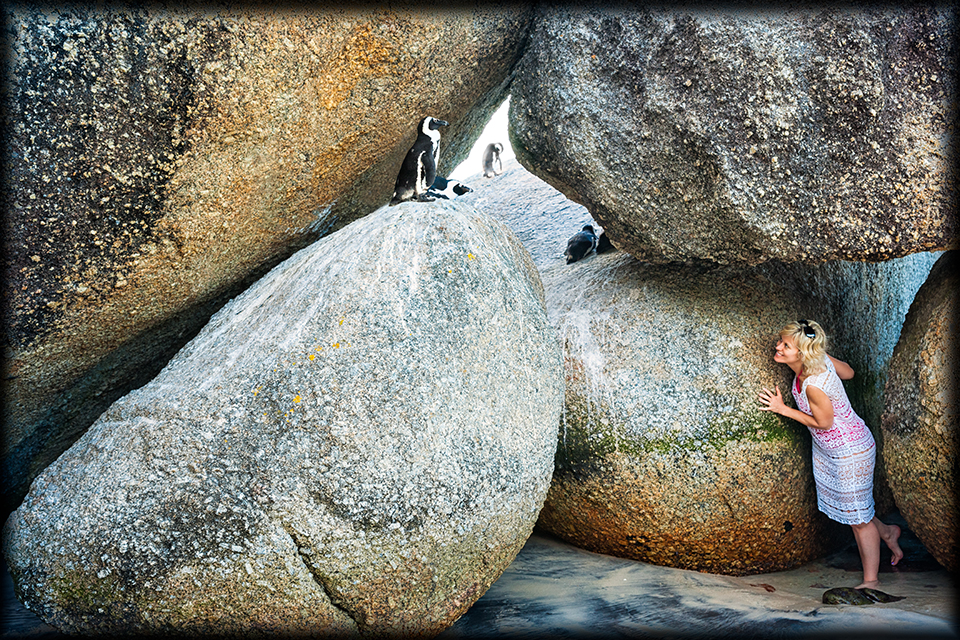
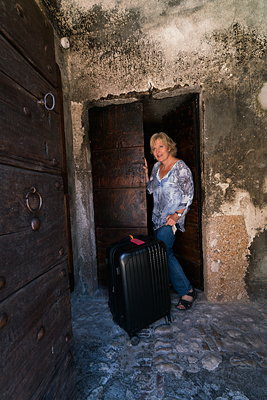
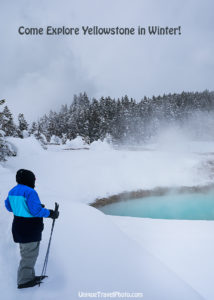
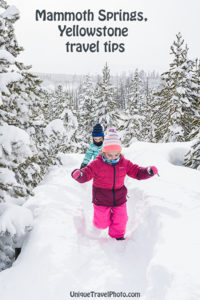
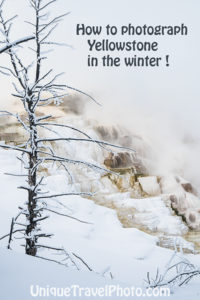
David Miller - Kim, as always, your photos are great. Your description of the Yellowstone area left me chilled to the bone. Thanks for posting. See you soon.
admin - thanks, David!!
Thomas Barrows - Wonderful blog Kim…FANTASTIC!!! I might just have to look into making the trip with my son if he’s game next year!
admin - I hope you get a chance to go—Yellowstone is so special in the winter!
Lauren Wallace - What is the best time of day in winter to photograph the springs? Sunrise or sunset?
Kim - I personally preferred sunrise. Awaken to a eerie world of steamy fog with no one else around…
Andrea Canfield - I just purchased the couples yello stone tour. I added a day on the front at Mommoth lodge because of weather and flight delays. We enjoy the winter and will bring snowshoes and micro spikes. But I was thinking of adding 2 more days there at the end of our Yellowstone tour. In Mammoth or Bozeman. Not sure there’s anything for us to do in Bozeman but shop. 🙄 This is a surprise for my husband’s 70th birthday. WhooHoo! Love your thoughts. And love this blog!
Kim Walker - Sounds like a great birthday surprise!! I LOVE Yellowstone in the winter. I’m not familiar with the couples tour you’ve signed up for or what activities are included, so hard to recommend anything specific. Mammoth lodge has some good snowcoach tours–really enjoyed the snowshoeing excursion tour. And just getting out and exploring the snowy walkways around Mammoth lodge. I’ve visited Bozeman twice and enjoyed staying a couple nights in that cute town. There are ice canyons out of town where people ice climb down frozen waterfalls and also trails to xc ski. And snowskiing too not so very far away east of Bozeman (I stayed at Fox B&B near the ski resort, and yes they had foxes!) So really there’s much to do, just depends on what you want to do. Also nice to have a day to just unwind at the end of a busy, active week in the historic lodge I must admit! Hope you have an awesome trip.